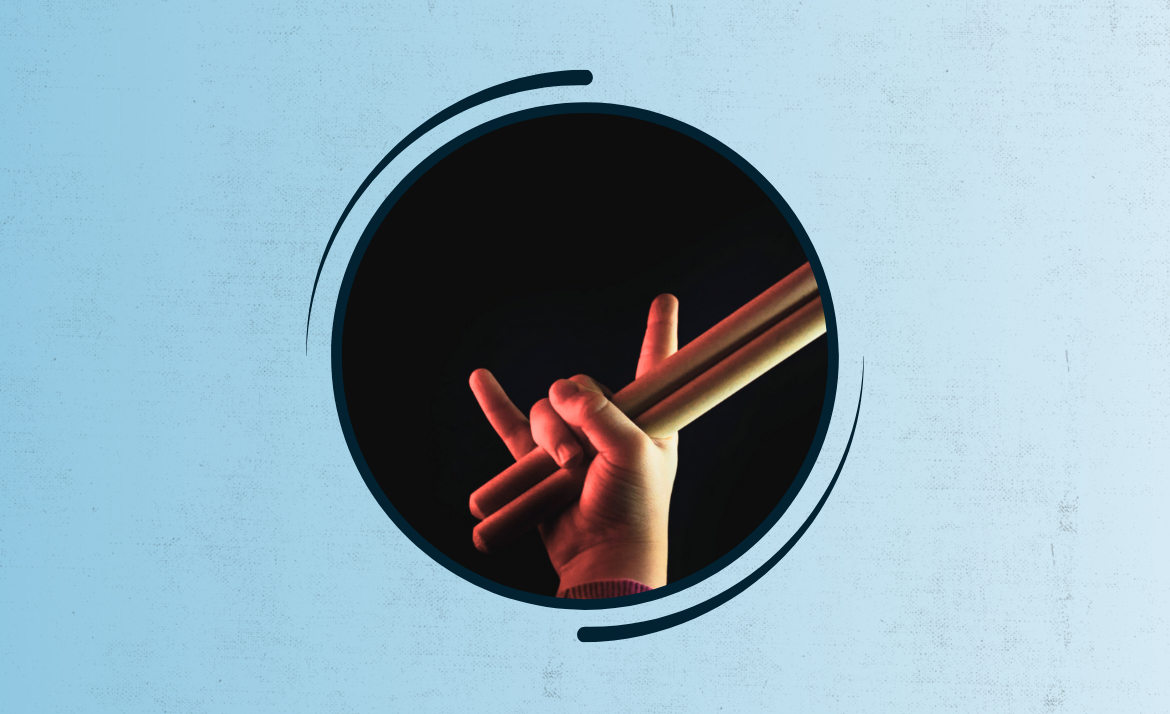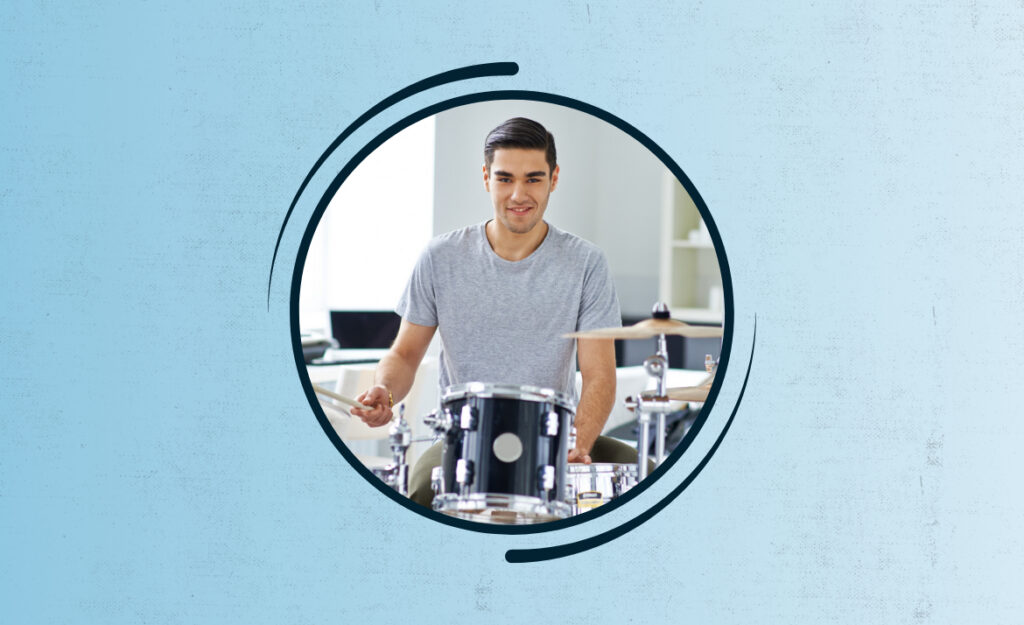Sitting down to play a drum set feels thrilling—until an aching back or sore shoulders cut the fun short. Hidden habits in your drum posture can create wear and tear surprisingly fast, even if you’re just starting out or only jam on weekends.
Staying healthy behind the kit matters. Good drum posture isn’t just about comfort; it’s your strongest defense against chronic aches, fatigue, and injury. Players who shape these healthy habits at every practice stick with drumming longer and feel better along the way.
Let’s explore simple, practical ways to check your form, adjust your setup, and adopt habits that support strong, consistent drumming for years to come. You’ll play more confidently and keep pain at bay—no matter your experience level.

Setting Up Your Drum Kit With Protection In Mind
Getting your kit ergonomically right is the fastest way to minimize aches. Set each piece for easy access and a posture that supports the longevity of your drumming career.
A well-organized drum layout means less reaching and twisting, translating into fewer overuse injuries and a more relaxed, efficient playing style that stands the test of time.
Snare Height and Positioning Secrets for Supported Playing
Position your snare drum so your elbows stay slightly below your shoulders when your sticks hover above the drumhead. This natural arm angle keeps shoulder strain away while letting your wrists flow naturally.
If you find yourself shrugging or slouching to reach the snare, raise or lower the drum until your forearm feels relaxed and your back remains upright. Take breaks and reset your posture if you notice hunching.
Experiment during warm-ups by shifting the snare one inch up or down, or pulling it closer to your knees. Notice how small changes affect your comfort over a 20-minute session and settle on what lets you breathe easily.
Hi-Hat, Toms, and Cymbal Height That Reduce Stress
Place your hi-hat so your left hand crosses the snare at a light angle, not an extreme one. This keeps your grip relaxed and avoids wrist tweaks from awkward reaches or over-rotation.
Angle your rack toms slightly toward you at chest height, never flat or parallel to the floor. This encourages a slight arm drop, supporting natural stick rebound while reducing elbow locking or tension.
Crash or ride cymbals should land in line with your shoulder or just outside, never far above eye level. If you can tap a cymbal with a relaxed arm swing, you’ve found a spot that preserves long-term joint health.
| Kit Element | Best Position | Warning Sign | Action Step |
|---|---|---|---|
| Snare Drum | Elbows lower than shoulders | Shoulder tension | Lower/raise drum 1 inch, test for comfort |
| Rack Toms | Angled towards chest | Stiff elbows | Adjust tilt gently, test stick flow |
| Bass Drum | Directly in front, not offset | Knee pain | Shift pedal or stool, reset alignment |
| Hi-Hat | Near left hand, easy reach | Twisted torso | Move closer, keep back straight |
| Cymbals | Shoulder height, not overhead | Neck or arm ache | Lower by half an inch, monitor tension |
Positioning Your Body to Avoid Strain From Day One
Your body’s placement shapes how power and movement flow while drumming. Good drum posture protects you from accumulative damage and helps every session feel smooth and low-stress.
Sit with your feet flat on the pedals and your back upright. Think of a line running down from your ears through your shoulders to your hips—this will support both your playing and recovery between sets.

Drumstick Grip Techniques to Prevent Slipping Hands
Drumstick grip techniques can make all the difference for drummers—get real solutions to prevent slipping hands!Foot, Knee, and Thigh Placement for All-Day Comfort
Let your knees angle slightly downward rather than flat or pulled up. This opens your hip flexors and gives stability without compressing your spine or lower back. Adjust your throne height until your knees rest a few degrees lower than your hips for an instant comfort boost.
- Stretch calves gently before sitting: Increase pedal mobility and reduce cramping during long double kick sections by flexing your ankles and calves for sixty seconds before you play.
- Keep feet flat, not on tiptoes: Place your entire foot on both the hi-hat and bass pedals for maximum leverage and leg relaxation, even during fast patterns or high-energy fills.
- Switch pedal techniques during warm-ups: Alternate between heel-up and heel-down styles every few minutes. This activates different muscle groups and prevents fatigue in any single area, preserving stamina across sets.
- Relax knees between songs: Between tunes or practice reps, drop your heels and gently tap your knees outward to release built-up tension and increase circulation for longer, pain-free sessions.
- Maintain equal distance: Keep both legs an equal space from the center line of your body so your pelvis remains balanced, which keeps your lower back from straining during complicated grooves or extended jams.
Drummers who focus on these details early build endurance without soreness and enjoy smoother footwork in every style.
Shoulder, Elbow, and Wrist Alignment to Protect Joints
Keep elbows slightly bent, shoulders relaxed, and wrists neutral during all movements. If you feel tingling or numbness in your hands, immediately shake out your arms and check your grip for excess tension.
- Use light grip pressure: Hold your sticks just tight enough to maintain control—not so hard that your knuckles turn white. This encourages resilient bounce and rhythmic flexibility while fighting off hand fatigue.
- Elbows aim downward, not outward: Tuck your elbows in toward your body instead of letting them flare. This increases accuracy and minimizes shoulder aches, especially during fast hi-hat runs or rimshot-heavy sections.
- Stop if you tense your forearms: During tough fills, pause and drop your arms loosely at your sides for ten seconds, allowing built-up tension to dissipate fast before repetitive-use injuries start.
- Alternate hand lead: Switch which hand starts each exercise or fill. This trains both wrists to handle bursts of speed and power, evening out muscular workload and sidestepping chronic imbalance.
- Rest between practice chunks: After ten or fifteen minutes, set your sticks down, open and close your hands, and gently roll your wrists in circles. This promotes blood flow and protects delicate joint and tendon health from session to session.
Stay consistent with these simple protective actions, and your upper body will stay flexible and ready, even as you progress to advanced drumming skills.
Lighting and Visual Focus That Minimizes Fatigue
Playing with clear sightlines and steady lighting reduces fatigue in your eyes, neck, and upper back. These visual details reinforce healthy drum posture for long gigs and focused recording sessions.
Avoid squinting or craning your neck to watch your hands or read charts, and keep peripheral distractions out of your playing area whenever possible. Good habits here set you up for confident, pain-free performances.
Positioning Music Stands and Devices Within Easy View
Arrange your music stand or device holder just above snare height and close enough to read easily, even in low light. This prevents awkward leaning that strains your neck or spine during rehearsals.
If you use a tablet, attach a lightweight stand to your hi-hat or cymbal stand for direct eye-line sight. Keeping your gaze level reduces eye strain and eliminates subtle slouching that can build into bigger posture issues.
One working drummer says, “I slide my stand a couple inches left or right until I can glance quick and return my focus center. No extra reach, no back pain.” Copy this approach by making 1-inch adjustments every session until your field of vision feels balanced and fatigue-free.
Ambient Lighting and Screen Brightness for Eye-Back Health
Brighten your practice area with soft, diffuse light—either from behind your kit or overhead—not just direct beams from above. This means your eyes work less, and you’re less tempted to lean closer as you play.
If playing at night, dial up screen brightness but use a warm background or night mode to minimize blue light exposure. This keeps eyes from drying out or overworking, helping you concentrate longer without squint-induced headaches.
Between songs or takes, look up and scan the room briefly to refresh your vision. Setting a phone or kitchen timer for five minutes as a reminder helps build this habit, reinforcing both drum posture and long-term comfort.
Making Micro-Adjustments During Long Practice Sessions
During extended rehearsals or gigs, small shifts in your drum posture pay dividends. Learning to sense when tension is building—and how to release it—can mean the difference between finishing strong or hobbling home.
Every thirty or forty minutes, check your seat height, arm angle, and pedal reach, then stand up if you feel stiff. Proactive self-checks keep fatigue from sneaking up on you.
Quick Seated Exercises to Loosen Up Fast
Roll each shoulder forward and backward five times while seated, then shrug up and drop your arms. Try big, slow breaths as you pull your belly gently in, promoting core activation that supports your spine naturally while drumming.
Flex your ankles and pedals as if gently tapping out sixteenth notes with no volume. This increases circulation, releasing tension in your calves and feet. Don’t be afraid to stand and stretch out your hamstrings every hour during practice breaks.
Blink rapidly for ten seconds, then focus far across the room for a visual reset. These micro-breaks reduce total strain and help rejuvenate your concentration for more consistent playing throughout the session.
Adjust Throne or Pad Placement to Match Changing Needs
If your lower back tightens, shift your stool backward by an inch and notice how your hip angle changes. Sometimes just a small adjustment rebalances your weight, redistributing effort across your whole body.
During dynamic drumming, rotate your seat slightly left or right until both feet feel evenly grounded. This keeps hip flexors from fatiguing and lets you find stronger leg drive on demanding kick patterns or hi-hat accents.
Notice when your thighs sink or lift above parallel. Sliding your throne half an inch higher or lower often removes pressure from your knees, allowing better blood flow and banishing numbness even during multi-hour rehearsals.
Breathing and Core Engagement for Powerful, Pain-Free Performance
Every drummer can fuel their groove and shield their joints by aligning breath with movement. Focused breathing and core support amplify energy on the kit, protect your spine, and allow sharp, dynamic passages without physical strain.
Inhale through your nose before each fill or accent, then exhale as your sticks land. Feel your ribcage lift and your waist expand—not your shoulders lifting—creating stability that’s both powerful and protective over hours of play.

Building a Core-Breath Pattern That Supports Each Stroke
Think of your core as your drumming engine—if it’s braced, energy transfers smoothly from torso to limb. Try exhaling gently as you strike, keeping your abs firm but not tense, syncing rhythm with breath for smooth, relaxed motion.
Use low abdominal breathing rather than shallow chest breaths. It’s like filling a balloon at your waistband, not your collar. This gently stabilizes your lower spine, fighting mid-session slouching and fatigue by providing a steady center for every hit.
Alternate deep and shallow breaths between fast passages, noticing tension in your midsection. Each time you hit a groove, ask yourself, “Am I breathing or bracing?” Use this as your reminder to realign and reset drum posture.
Rhythmic Movement and Stretching to Support Drum Posture
Incorporate rhythmic micro-movements and stretching exercises before and after practice to protect muscles and foster a fluid drumming style. These routines not only aid recovery but also enhance your agility during complex grooves or fills.
Think of your body as a spring—flexible, absorbing impact and bouncing back instead of locking rigid through technical passages. This mindset reduces the rigid holding patterns that lead to cumulative pain.
- Start each session with 3 minutes of torso twists: Rotate slowly starting at the hips, loosening your lower back and oblique muscles. This engages your core while creating full-body readiness for seated playing.
- Stretch arms overhead and interlace fingers: Lift arms above your head, locking fingers, then reach up for fifteen seconds. This opens up shoulder joints, resets your posture, and counteracts the hunch from intensive snare work.
- Alternate toe and heel rises on the pedals: Rock between the ball and heel of your foot while resting on each pedal. This preps your ankle responses and helps muscles fire evenly along your shins and calves.
- Roll wrists in slow circles with sticks: Hold both sticks gently and rotate your wrists both directions, lubricating joints and warming tendons for consecutive, precise motion.
- Conclude practice with hamstring stretches: Either standing or seated, reach gently toward your toes for twenty seconds, lengthening the back of your legs to ease pressure on your lower spine.
Integrate these stretching and movement drills daily. They’ll boost flexibility, stave off aches, and sharpen your technique from the ground up.
Staying Healthy and Playing Strong: Your Next Steps
Setting up your kit ergonomically, checking your drum posture often, and weaving micro-movements into practice routines form the best defense against drumming pain. Every adjustment—no matter how subtle—compounds your well-being over time.
By aligning your play with thoughtful breathing and a strong core, you’ll develop strength and resilience that serve you on every stage or session. Make small check-ins part of your routine, so comfort becomes second nature behind the kit.
Stay invested in these best practices, and your drumming journey will not only get longer, but more enjoyable at every step. Your body—and your music—will thank you with every healthy, confident beat.



